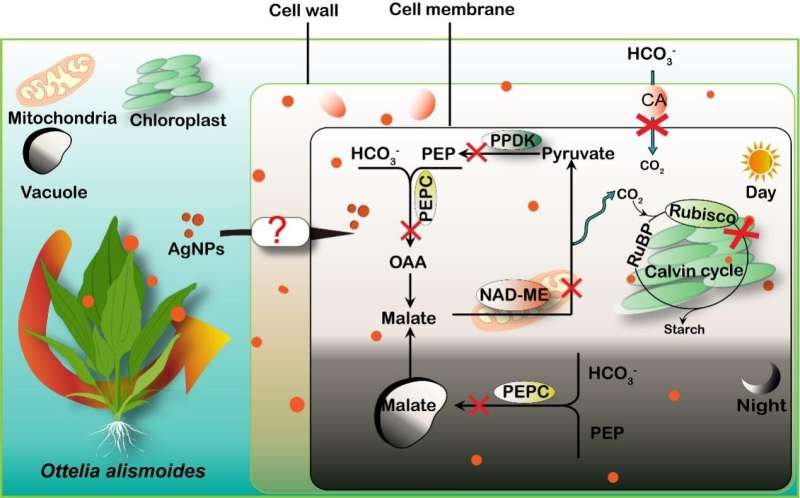This article has been reviewed according to Science X's editorial process and policies. Editors have highlighted the following attributes while ensuring the content's credibility:
fact-checked
peer-reviewed publication
trusted source
proofread
Study elucidates effects of silver nanoparticles on inorganic carbon utilization of submerged macrophytes

Submerged macrophytes grow underwater and represent a group of higher plants adapted to the aquatic environments. As they grow in water, the uptake of inorganic carbon is very different from that of terrestrial plants. However, the diversity and abundance of submerged macrophytes have been declining in recent decades, and pollutants discharged into aquatic ecosystems may be one of the main factors.
Silver nanoparticles (AgNPs) have become one of the emerging contaminants due to their worldwide use for the excellent broad-spectrum antibacterial properties. However, little is known about the side effects of AgNPs on photosynthetic inorganic carbon utilization in submerged macrophytes.
Researchers from the Wuhan Botanical Garden of the Chinese Academy of Sciences investigated the effects of AgNPs on inorganic carbon utilization in submerged macrophytes using Ottleila alismoides, the only submerged macrophyte with three CO2-concentrating mechanisms.
They found that as soon as the submerged macrophytes contacted with the released AgNPs, prior to absorption, the AgNPs immediately inhibited the activity of external carbonic anhydrase located at the periplasmic space thus reducing the capacity of the plant to use bicarbonate.
After being absorbed into the submerged macrophytes, AgNPs aggregated mainly at the cell wall and in the chloroplast. The internalized AgNPs then significantly inhibited the activity of ribulose 1,5-bisphosphate carboxylase-oxygenase (Rubisco) to fix CO2 thereby blocking the Calvin cycle.
Meanwhile, the internalized AgNPs disturbed C4 and crassulacean acid metabolism (CAM) by inhibiting the activity of phosphoenolpyruvate carboxylase (PEPC), pyruvate phosphate dikinase (PPDK) and NAD-dependent malic enzyme (NAD-ME) to alter intracellular malate biosynthesis and decarboxylation.
Due to the divergent response to AgNPs among the inorganic carbon utilization pathways (different sensitivity of external carbonic anhydrase, Rubisco, PEPC, PPDK, and NAD-ME to AgNPs exposure), the discharged AgNPs could disturb the balance of the species with different inorganic carbon utilization strategies, which may alter the species composition of freshwater plant communities and the carbon cycle in the aquatic systems, especially the CO2 and bicarbonate fixed users.
This interference may alter the species compositions of freshwater plant communities and the carbon cycle in aquatic systems, which should be considered in future studies.
Results, titled "Inorganic carbon utilization: A target of silver nanoparticle toxicity on a submerged macrophyte," have been published in Environmental Pollution.
More information: Wanwan Wang et al, Inorganic carbon utilization: A target of silver nanoparticle toxicity on a submerged macrophyte, Environmental Pollution (2022). DOI: 10.1016/j.envpol.2022.120906
Journal information: Environmental Pollution
Provided by Chinese Academy of Sciences




















